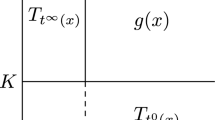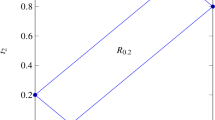Abstract
We introduce a correspondence between dimer models (and hence superconformal quivers) and the quantum Teichmüller space of the Riemann surfaces associated to them by mirror symmetry. Via the untwisting map, every brane tiling gives rise to a tiling of the Riemann surface with faces surrounding punctures. We explain how to obtain an ideal triangulation by dualizing this tiling. In order to do so, tiling nodes of valence greater than 3 (equivalently superpotential terms of order greater than 3 in the corresponding quiver gauge theories) must be decomposed by the introduction of 2-valent nodes. From a quiver gauge theory perspective, this operation corresponds to integrating-in massive fields. Fock coordinates in Teichmüller space are in one-to-one correspondence with chiral fields in the quiver. We present multiple explicit examples, including infinite families of theories, illustrating how the right number of Fock coordinates is generated by this procedure. Finally, we explain how Chekhov and Fock commutation relations between coordinates give rise to the commutators associated to dimer models by Goncharov and Kenyon in the context of quantum integrable systems. For generic dimer models (i.e. those containing nodes that are not 3-valent), this matching requires the introduction of a natural generalization of Chekhov and Fock rules. We also explain how urban renewal in the original brane tiling (Seiberg duality for the quivers) is mapped to flips of the ideal triangulation.
Similar content being viewed by others
References
S. Franco, A. Hanany, K.D. Kennaway, D. Vegh and B. Wecht, Brane dimers and quiver gauge theories, JHEP 01 (2006) 096 [hep-th/0504110] [SPIRES].
H. Ooguri and M. Yamazaki, Crystal melting and toric Calabi-Yau manifolds, Commun. Math. Phys. 292 (2009) 179 [arXiv:0811.2801] [SPIRES].
B. Feng, Y.-H. He, K.D. Kennaway and C. Vafa, Dimer models from mirror symmetry and quivering amoebae, Adv. Theor. Math. Phys. 12 (2008) 3 [hep-th/0511287] [SPIRES].
S. Franco et al., Dimers and orientifolds, JHEP 09 (2007) 075 [arXiv:0707.0298] [SPIRES].
S. Franco et al., Gauge theories from toric geometry and brane tilings, JHEP 01 (2006) 128 [hep-th/0505211] [SPIRES].
A. Butti, D. Forcella and A. Zaffaroni, The dual superconformal theory for L(p, q, r) manifolds, JHEP 09 (2005) 018 [hep-th/0505220] [SPIRES].
S. Krippendorf, M.J. Dolan, A. Maharana and F. Quevedo, D-branes at toric singularities: model building, Yukawa couplings and flavour physics, JHEP 06 (2010) 092 [arXiv:1002.1790] [SPIRES].
A.B. Goncharov and R. Kenyon, Dimers and cluster integrable systems, arXiv:1107.5588 [SPIRES].
B. Feng, S. Franco, A. Hanany and Y.-H. He, Symmetries of toric duality, JHEP 12 (2002) 076 [hep-th/0205144] [SPIRES].
S. Franco and D. Vegh, Moduli spaces of gauge theories from dimer models: proof of the correspondence, JHEP 11 (2006) 054 [hep-th/0601063] [SPIRES].
R. Eager, S. Franco and K. Schaeffer, Dimer models and integrable systems, arXiv:1107.1244 [SPIRES].
R. Kenyon, A. Okounkov and S. Sheffield, Dimers and amoebae, math-ph/0311005 [SPIRES].
V.V. Fock, Dual Teichmüller spaces, math/9702018.
L. Chekhov and V.V. Fock, A quantum Teichmüller space, Theor. Math. Phys. 120 (1999) 1245 [Teor. Mat. Fiz. 120 (1999) 511] [math/9908165].
R. Kashaev, Quantization of Teichmüller spaces and the quantum dilogarithm, Lett. Math. Phys. 43 (1998) 105.
S. Benvenuti, S. Franco, A. Hanany, D. Martelli and J. Sparks, An infinite family of superconformal quiver gauge theories with Sasaki-Einstein duals, JHEP 06 (2005) 064 [hep-th/0411264] [SPIRES].
N. Nekrasov, Five dimensional gauge theories and relativistic integrable systems, Nucl. Phys. B 531 (1998) 323 [hep-th/9609219] [SPIRES].
H.L. Verlinde, Conformal field theory, 2D quantum gravity and quantization of Teichmüller space, Nucl. Phys. B 337 (1990) 652 [SPIRES].
J. Teschner, From Liouville theory to the quantum geometry of Riemann surfaces, hep-th/0308031 [SPIRES].
J. Teschner, Quantization of the Hitchin moduli spaces, Liouville theory and the geometric Langlands correspondence I, arXiv:1005.2846 [SPIRES].
Y. Terashima and M. Yamazaki, SL(2, R) Chern-Simons, Liouville and gauge theory on duality walls, JHEP 08 (2011) 135 [arXiv:1103.5748] [SPIRES].
I. Garcia-Etxebarria, F. Saad and A.M. Uranga, Quiver gauge theories at resolved and deformed singularities using dimers, JHEP 06 (2006) 055 [hep-th/0603108] [SPIRES].
L.F. Alday, D. Gaiotto and Y. Tachikawa, Liouville correlation functions from four-dimensional gauge theories, Lett. Math. Phys. 91 (2010) 167 [arXiv:0906.3219] [SPIRES].
Author information
Authors and Affiliations
Corresponding author
Rights and permissions
About this article
Cite this article
Franco, S. Dimer models, integrable systems and quantum Teichmüller space. J. High Energ. Phys. 2011, 57 (2011). https://doi.org/10.1007/JHEP09(2011)057
Received:
Accepted:
Published:
DOI: https://doi.org/10.1007/JHEP09(2011)057




